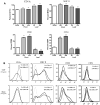Echinacea purpurea extracts modulate murine dendritic cell fate and function
- PMID: 20149833
- PMCID: PMC2883451
- DOI: 10.1016/j.fct.2010.02.007
Echinacea purpurea extracts modulate murine dendritic cell fate and function
Abstract
Echinacea is a top-selling herbal remedy that purportedly acts as an immunostimulant. However, the specific immunomodulatory effects of Echinacea remain to be elucidated. We focused on defining the effects of Echinacea purpurea extracts in dendritic cells (DCs), which generate innate and adaptive immune responses. We hypothesized that E. purpurea extracts would enhance murine bone marrow-derived DC (BMDC) activation leading to increased immune responses. The fate and function of DCs from C57Bl/6 mice was evaluated following 48h exposure to E. purpurea root and leaf extracts. Flow cytometry revealed that the polysaccharide-rich root extract increased the expression of MHC class II, CD86, and CD54 surface biomarkers whereas the alkylamide-rich leaf extract inhibited expression of these molecules. Production of IL-6 and TNF-alpha increased in a concentration-dependent manner with exposure to the root, but not leaf, extract. In contrast, the leaf but not root extract inhibited the enzymatic activity of cyclooxygenase-2. While both extracts decreased the uptake of ovalbumin by BMDCs, the leaf but not root extract inhibited the antigen-specific activation of naïve CD4(+) T cells from OT II/Thy1.1 mice. Collectively, these results suggest that E. purpurea can be immunostimulatory, immunosuppressive, and/or anti-inflammatory depending on the portion of the plant and extraction method.
Copyright (c) 2010 Elsevier Ltd. All rights reserved.
Figures




Similar articles
-
Echinacea purpurea Root Extract Increases Tumor Necrosis Factor Production by Concanavalin A-Activated Murine Splenocytes.J Med Food. 2019 Nov;22(11):1146-1150. doi: 10.1089/jmf.2019.0065. Epub 2019 Jul 8. J Med Food. 2019. PMID: 31274384
-
Mast cell degranulation and calcium influx are inhibited by an Echinacea purpurea extract and the alkylamide dodeca-2E,4E-dienoic acid isobutylamide.J Ethnopharmacol. 2018 Feb 15;212:166-174. doi: 10.1016/j.jep.2017.10.012. Epub 2017 Oct 14. J Ethnopharmacol. 2018. PMID: 29042288 Free PMC article.
-
Stimulatory effect of Echinacea purpurea extract on the trafficking activity of mouse dendritic cells: revealed by genomic and proteomic analyses.BMC Genomics. 2010 Nov 1;11:612. doi: 10.1186/1471-2164-11-612. BMC Genomics. 2010. PMID: 21040561 Free PMC article.
-
Echinacea species (Echinacea angustifolia (DC.) Hell., Echinacea pallida (Nutt.) Nutt.,Echinacea purpurea (L.) Moench): a review of their chemistry, pharmacology and clinical properties.J Pharm Pharmacol. 2005 Aug;57(8):929-54. doi: 10.1211/0022357056127. J Pharm Pharmacol. 2005. PMID: 16102249 Review.
-
[Echinacea drugs--effects and active ingredients].Z Arztl Fortbild (Jena). 1996 Apr;90(2):111-5. Z Arztl Fortbild (Jena). 1996. PMID: 8686333 Review. German.
Cited by
-
Echinacea purpurea L. (Moench) Hemagglutinin Effect on Immune Response In Vivo.Plants (Basel). 2021 May 7;10(5):936. doi: 10.3390/plants10050936. Plants (Basel). 2021. PMID: 34067195 Free PMC article.
-
[A preliminary survey on the interest of eating probiotics, cypress and echinacea to prevent the apparition of winter infections].Phytotherapie (Paris). 2011;9(2):120-125. doi: 10.1007/s10298-011-0613-x. Epub 2011 Mar 18. Phytotherapie (Paris). 2011. PMID: 32288746 Free PMC article. French.
-
Commonly Used Dietary Supplements on Coagulation Function during Surgery.Medicines (Basel). 2015 Sep;2(3):157-185. doi: 10.3390/medicines2030157. Epub 2015 Jul 27. Medicines (Basel). 2015. PMID: 26949700 Free PMC article.
-
Applications of the phytomedicine Echinacea purpurea (Purple Coneflower) in infectious diseases.J Biomed Biotechnol. 2012;2012:769896. doi: 10.1155/2012/769896. Epub 2011 Oct 26. J Biomed Biotechnol. 2012. PMID: 22131823 Free PMC article. Review.
-
Regulation of the exopolysaccharide from an anamorph of Cordyceps sinensis on dendritic cell sarcoma (DCS) cell line.Eur J Nutr. 2013 Mar;52(2):687-94. doi: 10.1007/s00394-012-0373-x. Epub 2012 May 19. Eur J Nutr. 2013. PMID: 22610670
References
-
- Banchereau J, Briere F, Caux C, Davoust J, Lebecque S, Liu YJ, Pulendran B, Palucka K. Immunobiology of dendritic cells. Annu Rev Immunol. 2000;18:767–811. - PubMed
-
- Barnden MJ, Allison J, Heath WR, Carbone FR. Defective TCR expression in transgenic mice constructed using cDNA-based and ß-chain genes under the control of heterologous regulatory elements. Immunol Cell Biol. 1998;76:34–40. - PubMed
-
- Bauer R. In: Phytomedicines of Europe. Lawson LD, Bauer R, editors. American Chemical Society; Washington, DC: 1998. p. 140.
-
- Bauer R. Chemistry, analysis and immunological investigations of Echinacea phytopharmaceuticals. In: Wagner H, editor. Immunomodulatory agents from plants. Basel, Boston, Berlin: Birkhäuserverlag; 1999. pp. 41–88.
-
- Borchers AT, Keen CL, Stern JS, Gershwin ME. Inflammation and Native American medicine: the role of botanicals. Am J Clin Nutr. 2000;72(2):339–347. - PubMed
Publication types
MeSH terms
Substances
Grants and funding
LinkOut - more resources
Full Text Sources
Research Materials
Miscellaneous

